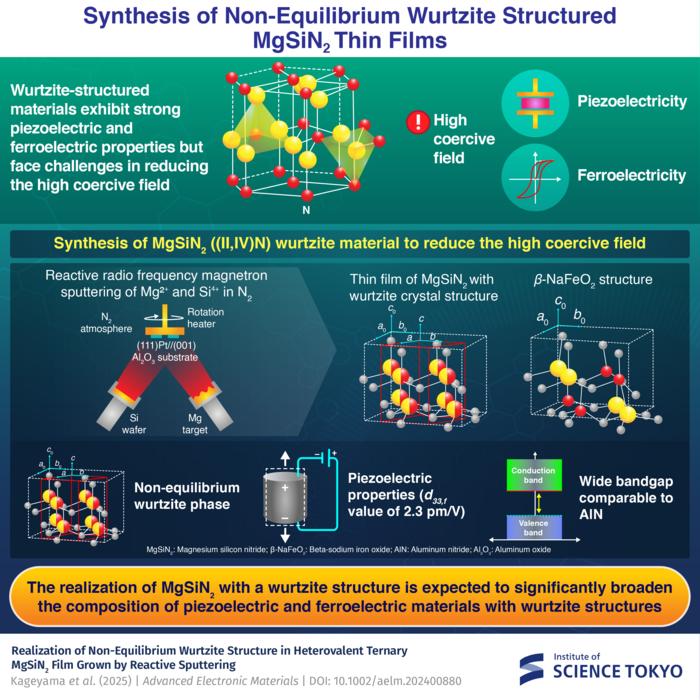Wurtzite-structured materials have long been revered for their unique characteristics, particularly in the realms of electronics and piezoelectric applications. The intriguing hexagonal symmetry of these crystals enables them to exhibit remarkable electronic and piezoelectric properties, notably their ability to generate an electric charge in response to mechanical stress. Among the most well-known examples are gallium nitride (GaN), essential for blue light-emitting diodes, and aluminum nitride (AlN), which plays a critical role in high-frequency radio frequency (RF) filters utilized in smartphones. These materials serve as the backbone for advanced semiconductor technologies, sensors, and actuators, thereby underscoring the importance of ongoing research into new materials with similar or superior properties.
In a groundbreaking development, scientists from the Institute of Science Tokyo have achieved a significant milestone in enhancing the applicability of the wurtzite crystal structure by expanding its scope to include heterovalent ternary nitrides. Their research, published online in Advanced Electronic Materials, highlights the fabrication of magnesium silicon nitride (MgSiN₂) as the first-ever heterovalent nitride with a wurtzite structure that exhibits promising piezoelectric properties. This innovative study was spearheaded by Professor Hiroshi Funakubo, alongside a team that includes researchers from various esteemed institutions, most notably Pennsylvania State University and Tohoku University.
Traditionally, wurtzite-structured crystals have been predominantly composed of trivalent cations. However, this has presented challenges due to high coercive electric fields that inhibit polarization switching necessary for effective piezoelectric charge generation. By incorporating heterovalent cations with different valencies, the researchers discovered a means to adjust the structural rigidity of these materials, subsequently facilitating polarization and reducing the coercive field. This foundational exploration into the effects of heterovalent doping in crystal structures marks a pivotal shift in the understanding of how these materials can be optimized.
The synthesis of MgSiN₂ was particularly innovative. This compound typically crystallizes in a different configuration, specifically the orthorhombic β-NaFeO₂ structure. The research team successfully managed to stabilize MgSiN₂ in the desired wurtzite phase through a highly controlled process known as reactive RF magnetron sputtering of magnesium and silicon ions at a consistent temperature of 600 °C within a nitrogen-rich environment. The process not only altered the crystal structure but also introduced a form of random cationic ordering which contributes to the material’s unique properties.
Collectively, this endeavor represents a major leap forward in the domain of piezoelectric materials. As highlighted by Professor Funakubo, the successful realization of MgSiN₂ in a wurtzite structure could catalyze the development of high-performance materials tailored for specific electronic applications. The implications of this research extend into numerous fields, including sensors, actuators, and energy harvesting systems, where materials that can effectively convert mechanical energy into electrical energy are crucial.
In addition to its piezoelectric attributes, the MgSiN₂ compound demonstrated an impressive wide bandgap of about 5.9 eV for direct transitions and 5.1 eV for indirect transitions. Such a wide bandgap is akin to that of established piezoelectric materials like wurtzite AlN, suggesting that MgSiN₂ possesses robust insulating properties. The ability to restrict electron mobility between the valence and conduction bands is indicative of a material that not only exhibits durability but is also stable under varying environmental conditions, further reinforcing its potential as a candidate for next-generation electronic devices.
The research team’s future trajectory remains focused on delving deeper into the realm of heterovalent ternary nitrides with piezoelectric and ferroelectric properties. They aim to refine the deposition parameters used during the synthesis process to uncover even greater improvements in polarization switching. This continued exploration will not only serve to validate the initial findings regarding the ferroelectric behavior of MgSiN₂ but will also enhance the understanding of how structural variations can influence functional properties in similar materials.
Overall, the emergence of wurtzite-structured MgSiN₂ represents an exciting frontier in material science, especially regarding piezoelectric and ferroelectric applications. As researchers delve deeper into novel material phases, the prospects for advancing electronic technologies become increasingly promising. The work carried out by the Institute of Science Tokyo not only demonstrates the profound potential of heterovalent doping strategies in improving material properties but also sets a new benchmark for future research endeavors aimed at harnessing the power of novel materials for technological advancement.
As a result, the integration of MgSiN₂ within the electronics landscape could lead to the development of innovative devices with higher efficiencies and tailored functionalities. This work exemplifies the critical interplay between material science and practical engineering, showcasing how fundamental research can pave the way for revolutionary advancements in technology. Whether it’s enhancing the capabilities of existing applications or crafting new technologies altogether, the implications of this research will undoubtedly resonate across several fields and industries.
In conclusion, the future looks bright for the promising applications of wurtzite-structured materials like MgSiN₂. Continued investigation into their properties and potential applications holds the key to unlocking the next generation of piezoelectric and ferroelectric technologies. The efforts of the researchers at the Institute of Science Tokyo lay a solid foundation for ongoing advancements, ushering in an era of enhanced performance and innovation in electronic materials.
Subject of Research: Heterovalent ternary nitrides with piezoelectric properties
Article Title: Realization of Non-Equilibrium Wurtzite Structure in Heterovalent Ternary MgSiN2 Film Grown by Reactive Sputtering
News Publication Date: 6-Feb-2025
Web References: https://advanced.onlinelibrary.wiley.com/doi/10.1002/aelm.202400880
References: 10.1002/aelm.202400880
Image Credits: Institute of Science Tokyo
Keywords
Wurtzite structure, piezoelectric materials, heterovalent nitrides, magnesium silicon nitride, advanced materials, electronic properties, material science, structural properties, semiconductor technology, energy harvesting.
Tags: advanced electronic applicationscollaboration in scientific researchelectric charge generationheterovalent ternary nitrideshexagonal crystal symmetryInstitute of Science Tokyomagnesium silicon nitridepiezoelectric applicationspiezoelectric propertiesresearch on new materialssemiconductor technologiesWurtzite structured materials





